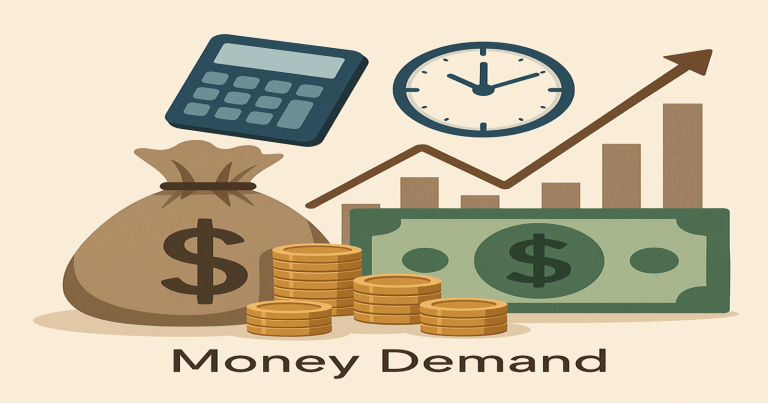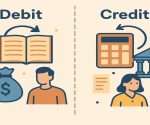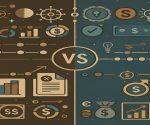Demand for money is an important concept in economics, especially in macroeconomics and monetary theory. It refers to the desire of individuals, businesses, and governments to hold money instead of other forms of wealth like bonds, shares, or physical assets. This money is usually held in the form of cash or bank deposits. People and institutions do not just want money to be spent right now but also to save for future needs or uncertainties.
Money has several uses—like buying goods, paying bills, or saving for emergencies—and this is why people demand it. However, the demand for money does not mean people want to earn money; it means how much money they want to hold at any given time.
What is the Demand for Money?
The demand for money means the amount of money that people in an economy want to keep with them in liquid form. It includes the cash in hand and money in bank accounts that can be easily used for transactions. This demand depends on many factors like income level, interest rate, price levels, and economic uncertainty.
People demand money not to increase their wealth but for practical reasons like:
- Making everyday purchases
- Paying regular bills
- Keeping money for unexpected expenses
Economists have studied this topic deeply and explained it through different theories. Let’s explore this concept further.
Types of Demand for Money
There are three main types of demand for money. British economist John Maynard Keynes first explained these in his famous theory. Each type is based on a specific reason for holding money.
1. Transaction Demand for Money
People need money for regular transactions, such as buying groceries, paying electricity bills, rent, or transport. This is called transaction demand. It mainly depends on the level of income—the higher the income, the higher the transaction demand.
Example: If a person earns ₹50,000 per month, they need a part of it in cash or in a bank account to spend throughout the month.
2. Precautionary Demand for Money
Such demand exists due to the fear of what might happen in the future. An average person sets aside some money for sudden medical emergencies, a shock loss of a job, and urgent travel needs.
Example: Keeping ₹5,000 in a savings account just in case of a medical emergency is a precautionary demand.
3. Speculative Demand for Money
Speculative demand is related to investment. People may avoid investing their money in stocks or bonds if they believe prices will fall. Instead, they hold money in cash to invest later at a better opportunity. This type of demand depends on interest rates—when interest rates are low, people prefer holding money.
Example: If bond prices are expected to fall, an investor may hold ₹1,00,000 in cash to buy bonds later at a lower price.
Theories of Demand for Money
Several economists have presented theories to explain how and why people demand money. Each theory focuses on different aspects.
1. Classical Theory
Classical economists like Irving Fisher believed that people demand money only for transactions. According to them, money is just a medium of exchange. Their famous equation is:
| MV = PT |
Where,
M = Quantity of money
V = Velocity of money (how fast money moves in the economy)
P = Price level
T = Volume of transactions
This theory ignored speculative and precautionary motives.
2. Keynesian Theory
John Maynard Keynes gave a broader view by including all three motives—transaction, precautionary, and speculative. He said that interest rate is a major factor influencing speculative demand. His theory introduced the idea that people hold money not only for spending but also for investment decisions.
3. Friedman’s Modern Theory
Milton Friedman, a well-known economist, introduced a modern theory that linked the demand for money to wealth, not just income. According to him, money is just like other assets, and people choose how much to keep in cash depending on return, inflation, and risk.
He also believed that demand for money was stable in the long term, unlike Keynes, who thought it could change often.
Determinants of Demand for Money
The amount of money people want to hold depends on various factors. These factors are called the determinants of demand for money.
1. Income Level
As people earn more, their transaction and precautionary needs increase. So, the demand for money also rises with income.
2. Interest Rates
When interest rates are high, people prefer to invest in fixed deposits, bonds, etc., and hold less money. When interest rates are low, people keep more money in cash.
3. Price Level
Higher prices mean people need more money for daily expenses. So, demand for money increases with inflation or rising price levels.
4. Financial Innovation
The use of credit cards, UPI, and net banking reduces the need to hold cash. So, modern financial tools reduce the demand for physical money.
5. Expectations about the Future
If people expect economic instability or job loss, they may keep more cash. In contrast, in stable economies, they feel safe investing their money.
Importance of Demand for Money
The Reserve Bank of India and governments need to understand the demand for money to gauge their control levels over inflation, interest rate, and the economy itself.
- Monetary Policy: RBI adjusts the money supply in the economy based on demand to control inflation.
- Interest Rates: Helps in deciding repo and reverse repo rates.
- Economic Stability: High or low demand signals economic confidence or fear.
- Liquidity Management: Helps businesses and banks to manage cash flow better.
Demand for Money vs. Supply of Money
While demand for money is the desire to hold money, supply of money is the total amount of money available in the economy. The interaction between the two effects:
- Interest rates
- Inflation
- Savings and investment decisions
If demand is more than supply, people may borrow more, which increases interest rates. If supply is more than demand, interest rates fall.
Example of Demand for Money
Let’s say a middle-class family in India earns ₹60,000 per month. They keep ₹30,000 for regular monthly expenses like food, rent, and travel (transaction demand). They save ₹10,000 for emergencies (precautionary demand). If they are unsure about investing in mutual funds due to market risks, they keep ₹20,000 as cash or in savings accounts (speculative demand). Together, this makes up their total demand for money.
Demand for Money FAQs
Q1. What does the demand for money mean?
It means how much cash or liquid money people want to keep instead of investing it.
Q2. What are the types of demand for money?
Transaction, precautionary, and speculative demand.
Q3. Who gave the concept of demand for money?
John Maynard Keynes explained it in detail through his liquidity preference theory.
Q4. How does interest rate affect demand for money?
Higher interest rates reduce speculative demand. Lower interest rates increase it.
Q5. What is the difference between demand and supply of money?
Demand is the desire to hold money, while supply is the total money available in the economy.


